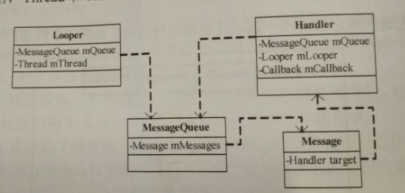Android異步消息處理機制實現原理詳解
消息處理機制主要對象:Looper,Handler,Message(還有MessageQueue和Runnable)
Looper不斷從MessageQueue消息隊列中取出一個Message,然后傳給Handle,如此循環往復,如果隊列為空,那么它會進入休眠。
這些類的主要變量
Looper.java
static final ThreadLocal<Looper> sThreadLocal = new ThreadLocal<Looper>(); private static Looper sMainLooper; // guarded by Looper.class final MessageQueue mQueue; final Thread mThread;
Handler.java
final MessageQueue mQueue; final Looper mLooper; final Callback mCallback; final boolean mAsynchronous; IMessenger mMessenger;
Message.java
Handler target;每個消息只能對應一個handlerRunnable callback;回調接口
MessageQueue.java
Message mMessages;
Runnable是一個空接口類,沒有變量
上一個書上的圖:

Handler和Thread沒有直接關系,但對應關系可以推理得到
每個Thread只對應一個Looper;
每個Looper只對應一個MessageQueue;
每個MessageQueue對應N個Message,每個Message只對應一個Handler
==》每個Thread對應N個Handler。
Handler是”真正處理事情“的地方,作用:處理消息,將Message壓入MessageQueue中
帶著一個問題看源碼:創建handler對象的線程(ui/主線程除外)為什么,必須先調用Looper.prepare() ?
public Handler() { this(null, false); }public Handler(Callback callback) { this(callback, false); }public Handler(Looper looper) { this(looper, null, false); } public Handler(Looper looper, Callback callback) { this(looper, callback, false); } public Handler(boolean async) { this(null, async); }public Handler(Callback callback, boolean async) { if (FIND_POTENTIAL_LEAKS) { final Class<? extends Handler> klass = getClass(); if ((klass.isAnonymousClass() || klass.isMemberClass() || klass.isLocalClass()) && (klass.getModifiers() & Modifier.STATIC) == 0) {Log.w(TAG, 'The following Handler class should be static or leaks might occur: ' + klass.getCanonicalName()); } } mLooper = Looper.myLooper(); if (mLooper == null) { throw new RuntimeException('Can’t create handler inside thread that has not called Looper.prepare()'); } mQueue = mLooper.mQueue; mCallback = callback; mAsynchronous = async; } public Handler(Looper looper, Callback callback, boolean async) { mLooper = looper; mQueue = looper.mQueue; mCallback = callback; mAsynchronous = async; }
初始化handler對象時(構造方法是Handler(),Handler(Callback callback))都間接調用Handler(Callback callback, boolean async)構造方法
主要代碼是Looper.myLooper();
static final ThreadLocal<Looper> sThreadLocal = new ThreadLocal<Looper>();//這是在Looper類中的定義public static Looper myLooper() { return sThreadLocal.get();//從當前線程中獲得looper對象 }public static void prepare() {prepare(true);}private static void prepare(boolean quitAllowed) {if (sThreadLocal.get() != null) {throw new RuntimeException('Only one Looper may be created per thread');}sThreadLocal.set(new Looper(quitAllowed));//為當前線程設置looper對象}
我們自己創建線程必須通過Looper.prepare()方法為當前線程設置looper對象才可以通過Looper.myLooper()方法返回looper對象,這樣在非UI線程創建handler對象時才不會報錯。'Can’t create handler inside thread that has not called Looper.prepare()'
ps:prepare(boolean quitAllowed)(這個不用我們關心,略過。。)
這個quitAlowed參數是定義消息隊列用了,看的源代碼是android4.4
Looper.javaprivate Looper(boolean quitAllowed) { mQueue = new MessageQueue(quitAllowed); mRun = true; mThread = Thread.currentThread(); }MessageQueue.java// True if the message queue can be quit. private final boolean mQuitAllowed;//true消息隊列可以被quit,false消息隊列不能被quit。
主線程/UI線程的MessageQueue不能被銷毀掉。看源碼(銷毀調用Looper.quit())
public static void prepareMainLooper() { prepare(false); synchronized (Looper.class) { if (sMainLooper != null) {throw new IllegalStateException('The main Looper has already been prepared.'); } sMainLooper = myLooper(); } }
偏離太遠了
所以得出結論:創建handler對象的線程(ui/主線程除外),必須先調用Looper.prepare()
Handler作用1:處理消息
在Looper類中處理消息是通過msg.target.dispatchMessage(msg);target就是handler對象(Message類的內部變量Handler target)將消息轉發到處理消息的對應的handler對象上,然后這個target即handler對象會在處理消息前做一個檢查
public void dispatchMessage(Message msg) { if (msg.callback != null) {//如果msg有綁定callback回調接口Runaable不為空,則執行Runnable的run方法 handleCallback(msg); } else { if (mCallback != null) {//如果handler的內置接口類Callback不為空,則執行boolean handleMessage(Message msg)這個方法if (mCallback.handleMessage(msg)) {執行完成則return return;} } handleMessage(msg);//最后才執行handler本身的方法 } } private static void handleCallback(Message message) { message.callback.run(); }public interface Callback {//handler的內置接口類Callbackpublic boolean handleMessage(Message msg); }
Handler作用2:將Message壓入MessageQueue中
handler中提供的很多發送message的方法,除了sendMessageAtFrontOfQueue()方法(直接調用enqueueMessage(queue, msg, 0);)之外,其它的發送消息方法最終都會輾轉調用到sendMessageAtTime()方法
public boolean sendMessageAtTime(Message msg, long uptimeMillis) { MessageQueue queue = mQueue; if (queue == null) { RuntimeException e = new RuntimeException( this + ' sendMessageAtTime() called with no mQueue'); Log.w('Looper', e.getMessage(), e); return false; } return enqueueMessage(queue, msg, uptimeMillis); }
sendMessageAtTime()方法也是調用Handler中的enqueueMessage(queue, msg, uptimeMillis)方法
和sendMessageAtFrontOfQueue()方法兩者最后都會調用enqueueMessage(queue, msg, uptimeMillis)方法
區別是需要延遲uptimeMillis時間后才將Message壓入MessageQueue中
private boolean enqueueMessage(MessageQueue queue, Message msg, long uptimeMillis) { msg.target = this;//給msg的target賦值為handler自身然后加入MessageQueue中 if (mAsynchronous) { msg.setAsynchronous(true); } return queue.enqueueMessage(msg, uptimeMillis); }
最終所有的方法都是調用MessageQueue中的enqueueMessage(msg, uptimeMillis);方法,是不是感覺兩個方法差不多啊,注意參數!!
MessageQueue的使用是在Looper中
Handler的作用整理完畢(好像我現在已經可以把Handler源碼完整默寫下來了。哈哈^.^記憶力真不行)
Looper類
作用:與當前線程綁定,保證一個線程只會有一個Looper實例,同時一個Looper實例也只有一個MessageQueue。
對于Looper主要是prepare()和loop()兩個方法
prepare()將普通線程轉化為looper線程,
loop()方法,不斷從MessageQueue中去取消息,交給消息的target屬性的dispatchMessage去處理。
public static void loop() { final Looper me = myLooper(); if (me == null) { throw new RuntimeException('No Looper; Looper.prepare() wasn’t called on this thread.'); } final MessageQueue queue = me.mQueue; // Make sure the identity of this thread is that of the local process, // and keep track of what that identity token actually is. Binder.clearCallingIdentity(); final long ident = Binder.clearCallingIdentity(); for (;;) { Message msg = queue.next(); // might block if (msg == null) {// No message indicates that the message queue is quitting.return; } // This must be in a local variable, in case a UI event sets the logger Printer logging = me.mLogging; if (logging != null) {logging.println('>>>>> Dispatching to ' + msg.target + ' ' + msg.callback + ': ' + msg.what); } msg.target.dispatchMessage(msg); if (logging != null) {logging.println('<<<<< Finished to ' + msg.target + ' ' + msg.callback); } // Make sure that during the course of dispatching the // identity of the thread wasn’t corrupted. final long newIdent = Binder.clearCallingIdentity(); if (ident != newIdent) {Log.wtf(TAG, 'Thread identity changed from 0x' + Long.toHexString(ident) + ' to 0x' + Long.toHexString(newIdent) + ' while dispatching to ' + msg.target.getClass().getName() + ' ' + msg.callback + ' what=' + msg.what); } msg.recycle(); } }
27行就是上面提到了,handler進行消息處理的關鍵代碼了
看著上面的分析很復雜,總結下
1、首先Looper.prepare()為在當前線程中保存一個Looper實例(sThreadLocal.set()),然后該實例中保存一個MessageQueue對象;因為Looper.prepare()在一個線程中只能調用一次,所以MessageQueue在一個線程中只會存在一個。
2、Looper.loop()會讓當前線程進入一個無限循環,不端從MessageQueue的實例中讀取消息,然后回調msg.target.dispatchMessage(msg)方法。
3、Handler的構造方法,會首先得到當前線程中保存的Looper實例,進而與Looper實例中的MessageQueue想關聯。
4、Handler的sendMessage方法,會給msg的target賦值為handler自身,然后加入MessageQueue中。
5、在構造Handler實例時,我們會重寫handleMessage方法,也就是msg.target.dispatchMessage(msg)最終調用的方法。
好了,總結完成,大家可能還會問,那么在Activity中,我們并沒有顯示的調用Looper.prepare()和Looper.loop()方法,為啥Handler可以成功創建呢,這是因為在Activity的啟動代碼中,已經在當前UI線程調用了Looper.prepare()和Looper.loop()方法。
以上就是本文的全部內容,希望對大家的學習有所幫助,也希望大家多多支持好吧啦網。
相關文章:

 網公網安備
網公網安備